by Rafaël Newman

Those of us employed in the city of Zurich got some extra time off last week. Every year, on the third Monday in April following the vernal equinox, the Zentralkomitee der Zünfte Zürichs—the Central Committee of Zurich Guilds, also known by its German initialism ZZZ—stages Sechseläuten, a festival featuring a parade and a bonfire. The event, whose pronunciation in the local dialect—Sächsilüüt—makes it sound a good deal sexier and lewder than it actually is, draws in equal parts on history, historicizing revival, and mythology, and is advertised by its promoters, with a prudent hedge, as “the largest Swiss Volksfest in Zurich.”
First the history. During the 14th century, in what would one day become Switzerland’s biggest city, the tradesmen’s guilds used their growing economic might to challenge the local patriciate and were able to establish a power-sharing arrangement, with the guilds and the nobles organized into a council with variously weighted competencies. Rudolf Brun (c. 1290-1360), the leader of the guild revolution in 1336 and Zurich’s first independent mayor, is commemorated in the name of a bridge over the Limmat in the Altstadt, on the route of the Sechseläuten parade.
Brun’s newfangled corporate oligarchy lasted into the 19th century, when, as the power of the guilds was waning amid the rise of capitalism and popular democratic ambitions, the traditional medieval and Renaissance costumes of the guildsmen began to be trooped each spring as a reminder of their bygone importance: this is the historicizing element in the etiology of Sechseläuten, akin to the “revival” and marketing of allegedly traditional tribal tartans in the early modern period in Scotland, as local Scottish power had in fact been weakened.
And finally, there is the festival’s mythological source: in memory of what the ZZZ insists on calling a “heathen” custom, the advent of spring in Zurich is celebrated in mid-April with winter burned in effigy, in a recreation of a putatively prehistoric rite. In fact, quite historically and in a triumph of the proto-Protestant work ethic, the medieval guilds had celebrated the approach of summer in a much less public manner: when the lengthening of the days meant that tradesmen no longer had to knock off at five pm, as the light grew too dim to work, and instead could await the end-of-work signal an hour later—hence the name of the event, which can be translated as “ringing the six o’clock bells”—they would gather for a drink and a toast to the longer working day. (That same Protestant work ethic, now fully mature, is also behind the fact that Sechseläuten provides merely for a half-day off, and only in the afternoon—which means that Zurich employees have to drag themselves into work early on Monday and stay till noon, rather than being allowed to sleep off the vestiges of the weekend and arrive at the office, fresh and rested, in time for lunch and parade-watching from their balconies.)

The revamped “heathen” ritual at the heart of Sechseläuten these days is rather more elaborate than an end-of-day beer at the pub. An oversized doll with the appearance of a jolly snowman is fashioned out of fabric, packed with gunpowder charges, and tied to a stake atop a massive pyre erected at a central location on Zurich’s lakeshore. At six o’clock precisely, following a three-hour costumed parade down the city’s main streets, the pyre bearing the snowman, or Böögg (a word cognate with our “bogeyman” and pronounced like the sound made by aroused poultry), is set alight. The time it takes for the fire to travel from the kindling at the bottom to the Böögg’s head, there to ignite the largest charge with a resounding bang, is said to foretell the quality of the coming summer. The record for speediest explosion at a Sechseläuten event is held by the 1968-1971 editions, when it took just five minutes for the Böögg’s head to blow up; the slowest record to date—57 minutes—was set just last year. And, as the flames lick up the sides of the pyre, the latter-day guildsmen—and they are only men: membership is handed down by father to son, with womenfolk relegated to lining the streets and tossing flowers—these guildsmen, clad in jerkins and jabots and tricornes, race their chivalrously caparisoned horses in a circle around the tumbrel, whooping and hallooing.

The whole thing has the weirdly dissonant energy of a public execution held on a genteel bank holiday, of a Columbus Day Parade crossed with a Klan rally: as if the local Chamber of Commerce had got together with a Civil War reenactment society to stage a cross-burning. Groundhog Day, but with incels. Certainly not what I had expected from a Volksfest when I first attended this particular version.
To be fair, I had been warned. Soon after we moved to Zurich in the late nineties, I took my kindergarten-age daughter and her best friend to watch the festivities. On our way downtown we met another father, a native Swiss and an amateur local historian, who dampened my enthusiasm for the coming festivities by explaining darkly that “Sechseläuten isn’t a Volksfest. It isn’t for you and me.”
A Volksfest, but not for the Volk? Well, as I was to find out over the next few years, in Switzerland it’s all a matter of which Volk you’re talking about. The author and social critic Jurczok 1001 performs a subversive rap on the rhetoric employed by the SVP, Switzerland’s ultra-rightwing Schweizerische Volkspartei (Swiss People’s Party), to exclude from the Swiss body politic immigrants and other undesirables, no matter how many generations their families have already been living here. Jurczok delivers the piece, entitled “Scheinbevölkerung”—Pseudo-population—in the characteristically bluff populist tone of Roger Köppel, the newspaperman turned SVP parliamentarian who has made a career of refashioning trendy media to transport regressive content:
What we have here, if we’re honest, is a pseudo-population, you may not even be aware of this, but it isn’t the population you see here, hasn’t been for a long time, no, in Switzerland we are far too gullible in this regard, of course, it looks like a population, everything humanly possible is undertaken in this pursuit, then they tell each other, this is how you have to behave here to give the impression and we should be under no illusions, the whole clan knows about it by now. They are real masters of media communication. The children are harnessed for these purposes at an early age, they adopt our language, they attend our schools, they go on to speak our languages at recess already, and they are doing it, that’s right, in the third generation now!*
The real Roger Köppel is regularly seen at Sechseläuten, decked out in the Orientalist habit of the Zunft zum Kämbel, or grocers’ guild, marching alongside other members of his party, as well as of the Free Democrats, the Swiss liberal party that is not much less rightwing than the SVP, with which it is happy to make common cause. At least Köppel is no longer required to sport blackface, as had until recently been the custom of the guild, whose escutcheon, the origin of its name and the source of its “Bedouin” costume, features an acquiescent-looking yellow camel on a field of azure.

This combination of racist politics and cultural appropriation with a celebration of longer working hours and patriarchal primogeniture renders its climactic element, the burning at the stake of a certain undesirable allegorical individual, particularly uncanny: Sechseläuten becomes a Protestant auto-da-fé, a latter-day witch-burning, the expiation of a people’s sins via the sacrifice of a scapegoat. That all of these appalling echoes are nevertheless drowned out by the innocence and good clean fun of a putative Volksfest is surely a testament to the human capacity for self-delusion—or perhaps to the tacit yearning for an acceptable version of those same bloodthirsty “heathen” spectacles, now transcended in the name of modernity: a virus that remains in the air, present to the Volk—or at least to one sort of Volk—but easily deniable, because so widely dispersed as to be invisible.
*
I recently attended a lecture at the Zurich James Joyce Foundation, an institution established in 1985 to promote research into the Irish modernist author and sometime resident of Zurich, and to house the collection of first editions, reference works, and memorabilia amassed by its director, the eminent Joyce scholar Fritz Senn. The speaker on that evening was Talia Abu, a member of the faculty of English at Tel Aviv University whose doctoral theme had been guilt in Finnegans Wake. Dr Abu was in Zurich to talk about vegetarianism in Joyce’s Ulysses, and the way Leopold Bloom, the novel’s protagonist and a noted afficionado of innards, exhibits a sudden revulsion regarding meat. In the question-and-answer session that followed the lecture, I wondered whether one of the reasons for Bloom’s ambivalence might be his partly Jewish heritage. After all, I suggested, the communion featured in the Catholic rite attended by his fellow Irishmen, and echoed in Ulysses in the scene of meat-eating that awakens the carnivore Bloom’s disgust, is an act of symbolic cannibalism, hence reprehensible to the fastidiously humanist Bloom. Indeed, I went on, the crucifixion at the heart of Christianity is a celebration of human sacrifice, whose renunciation by the Jewish rite, in the replacement of Isaac by the sacrificial lamb, is held by theorists like Gunnar Heinsohn to be among the sources of antisemitism, which holds Jews responsible for an ethics that would inhibit the violence integral to the Western project.

My comments were received in aghast silence—until another audience member, a regular attendee of the Finnegans Wake reading group held by the Foundation, responded. “You liken Catholic communion to cannibalism,” she stammered. “But cannibalism…cannibalism is…it’s a crime!”
“Le secret des grandes fortunes sans cause apparente est un crime oublié, parce qu’il a été proprement fait,” notes Balzac’s master criminal Vautrin; in Ellen Marriage’s translation, “The secret of a great success for which you are at a loss to account is a crime that has never been found out, because it was properly executed.” The greatness of Zurich’s success may be subject to a certain doubt these days, following the spectacular implosion of Credit Suisse last year, and the current inability (or unwillingness) of the relevant Swiss federal authorities to retool the country’s “Too Big To Fail” legislation to safeguard against a possible explosion of the gargantuan new UBS; but the secret crime at the city’s source, as at the source of Christianity’s success, remains hidden in plain view.
*
In the event, the Böögg’s head didn’t erupt at all last Monday—because the snowman was never set on fire in the first place. Switzerland had been in a meteorological low-pressure system in recent days; by the evening of April 15, 2024, the breeze in Zurich had picked up sufficiently to make the risk of flying sparks untenably great; and thus, as a precautionary measure, the fire warden called off the lighting of the pyre.
So perhaps the winds are changing after all.
___________________________________
* English translation from Rafaël Newman & Caroline Wiedmer, “Melinda Nadj Abonji and Jurczok 1001: Performance, Politics, and Poetry,” in Lyn Marven, Andrew Plowman and Kate Roy, eds., The Short Story in German in the Twenty-First Century (London: Camden Press, 2020).
